It was only a matter of time before New York’s (modest) Georgian cheese bread trend hit Williamsburg. But with Cheeseboat, opened about a year ago, the hipster-turned-yuppie neighborhood doesn’t do things half way. From the giant neon vulva representing an Adjaran khachapuri in the window, to a menu featuring well over a dozen different cheese breads, the joint is a shrine to the Georgian khachapuri in all its forms, unrivaled outside of the post-Soviet east.
The restaurant has already been reviewed by the New Yorker and the late Gothamist, which gives me a chance to relay a little bit about the owners. It turns out that Cheeseboat is a family affair, run by Netty Davit’ashvili, a Parsons alum, with her mother Kate Gochashvili, the latter newly arrived from Georgia to hold down the kitchen. Kate brought with her traditional recipes, as well as fresh twists on the classics. And that’s all I (and the New Yorker, and the Gothamist) have to say about that.
The decor has all the fixtures of the typical cozy New York restaurant: exposed brick walls, wooden furniture, large windows open onto the street (in warmer months), black board outside, an Edison bulb here and there. In fact, it’s not the first restaurant to occupy this spot at the corner of Berry and N. 9th, and I hear that Davit’ashvili/Gochashvili duo barely changed the space they inherited from the previous tenant, Italian/Latin eatery Miranda.
Looking at the menu, Cheeseboat offers the most tyropsomic (meaning “related to cheese bread”) selection I’ve seen in a long time, and it’s not afraid of being gimmicky. You can have your cheeseboat plain or with a choice of various combinations: spinach, ricotta, smoked gouda, chicken, beet greens, prosciutto, chorizo, Oaxaca cheese, meatballs, or lobster. If you prefer, there’s also Imeretian, Mingrelian, or Ossetian khachapuri, and bacon and truffle butter are offered as add-ons to several of them. There’s achma if you prefer pasta dough to bread dough, and chvishtari if you like cornbread. There’s even cheese pirozhki and cheese pierogi. All together, in addition to all the corners of Georgia, you’ll find cheese and bread dishes inspired by Mexico, Italy, New England, Russia, and Ukraine.
If somehow you’re not in the mood for cheese, the menu also features some classic Georgian appetizers (pkhali, eggplant rolls, stuffed grape leaves), soups (chikhirtma, kharcho), and mains (khinkali, lobio, kebabs). Add a few salads, fish dishes, and Russian dishes, and you’ve got plenty of options — the one category that’s underrepresented is the Georgian stews, with only a veal chakapuli. Just make sure your eyes aren’t bigger than your stomach, because portions are large!
On weekends, Cheeseboat feels obliged to serve brunch to people who’ve always wanted to try two eggs any style or a BLT in a Georgian restaurant. While the menu still features a few cheese breads and Georgian dishes, I would strongly suggest waiting until the evening to visit and eat normal food.
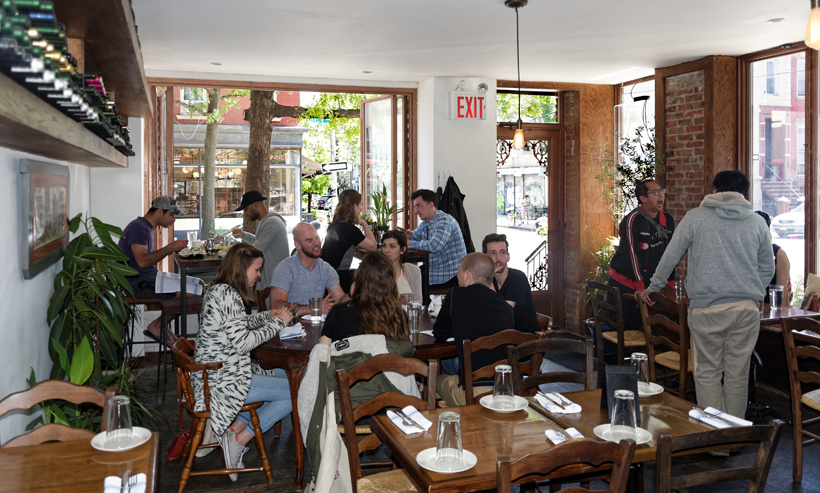
Let’s start with the inevitable eponymous cheeseboat, aka Adjaran khachapuri, aptly described on the menu as a “caldron of cheese with egg and butter.” It does come with the signature raw egg yolk and a nice chunk of butter (though European butter would have been my preference), and you’re supposed to combine them with the cheese, so that you can dip pieces of the bread into the mixture. The cheese blend is pretty spot on: it melts well, it’s salty but not too much so, and it tastes pretty similar to what I remember from my trips to Georgia. I can’t say exactly what cheese it is just from tasting it, but I was told it’s a blend of mozzarella and feta. Should you cry sacrilege because these aren’t Georgian cheeses? I don’t think so. I’d rather eat good mozzarella and feta than some low-quality Imeretian cheese and sulguni, and this substitute combination has long been favored by the Georgian diaspora. The bread itself is light and airy, chewy inside. A pinch more salt in the dough would make it more flavorful, and there’s slightly too much bread given the amount of cheese, but I’m splitting hairs. It remains a very good cheeseboat — with better butter, more salt in the dough, and less bread, it could have reached perfection.
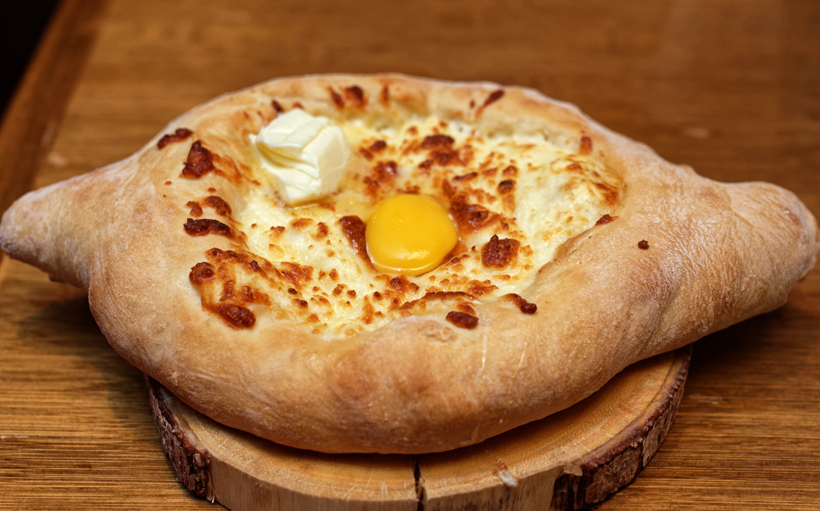
The Imeretian khachapuri (“most common cheesebread in Georgia, circular shaped bread with melting cheese filling”) is very large. The dough, described as “a tender yogurt dough,” is a little bit too soft. I know I’ve had similar Imeretian khachapuri elsewhere, but I still think it could be cooked more. In fact it’s better when you reheat the leftovers in the oven the next day, because it’s slightly crispier. The cheese seems to be the same blend as in the other breads, and the salt level is just right. Overall it’s another very good cheese bread. I wouldn’t mind eating it all the time!
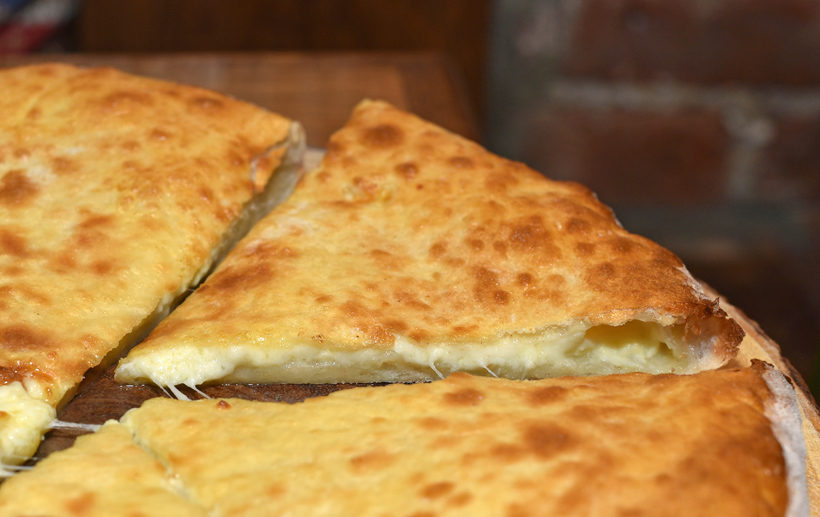
Can one really put too much cheese in a cheese bread? Yes. That’s what happens with the Mingrelian kachapuri — an Imeretian khachapuri with more cheese added on top, which makes it that much heavier. First off, the result is really gigantic and can easily feed four people as an appetizer. Then, even by the dish’s standards (and nobody in their right mind would ever consider giving any Mingrelian khachapuri to a lactose-intolerant person), it’s a craaaaaaazy amount of cheese. The center is almost 100% cheese, to the point where it’s hard to eat, while there’s less cheese on the outside. As I ate all these cheese breads over several meals, it’s hard to tell what differences should be attributed to slight changes in the preparation of any given day’s batch, to variations in my taste buds, or to actually different recipes. The dough is very airy but again lacks salt; I’d say it’s the same as the cheeseboat dough. I think that the cheese mixture here isn’t as flavorful as in the other breads, and maybe that extra cheese on top is straight Polly O’ mozz. Maybe I’m just imagining things. Regardless, while it’s still a satisfying dish, it could be better.

The Ossetian khachapuri, aka khabizgina, a “tender Ossetian cheese bread with potato and cheese filling,” is also similar to an Imeretian khachapuri, but chunky mashed potatoes are added to the cheese, which, again, makes it that much heavier and suitable to share with the whole table. The dough is the same as in the Imeretian khachapuri, the bread is golden brown on top with just a little color at the bottom; it also could have been baked some more. There’s a generous amount of filling, with more potatoes than cheese. I think the cheese is different from all of the other breads: it might be only feta, which also makes the mixture a bit too salty. On one hand, I like that the khabizgina tastes like potatoes, but on the other, I miss the cheese debauchery of the “regular” khachapuri. Combining potatoes with dough of some kind (bread, pasta, pie) has produced several staples of traditional subsistence food, but it doesn’t make for the most exciting meals once your goal is no longer merely to subsist. Still, this is a good Ossetian khachapuri.

Let’s move away from the cheese bread world, progressively, with the achma, “a kind of cheese lasagna found in the Adjara and Abkhazia regions, where the crisp top crust contrasts with the tender cheesy layer.” It looks nothing like the achmas I saw in Abkhazia — which isn’t to say that other places’ versions are better or worse. There’s way more cheese here (the same blend as in the cheeseboat), and the result is truly excellent. The interior layers of pasta are so soft, you can barely tell where the cheese ends and the pasta starts (looking at my pictures, I counted at least 6 layers). The bottom is crispy, and the top is browned to perfection. For all its excesses — giant slice, saturated with cheese — it might very well be the best achma I’ve ever had.

The soko ketze, “mozzarella-filled button mushrooms,” lets you have the cheeseboat’s cheese without the bread, though I wouldn’t yet call it the healthy option. It’s a simple enough dish: mushroom caps, covered with cheese, then baked and topped with scallions. It’s good, but the mushrooms render a lot water when they cook and it all ends up at the bottom of the dish —ideally they’d be sautéed first so this doesn’t happen.
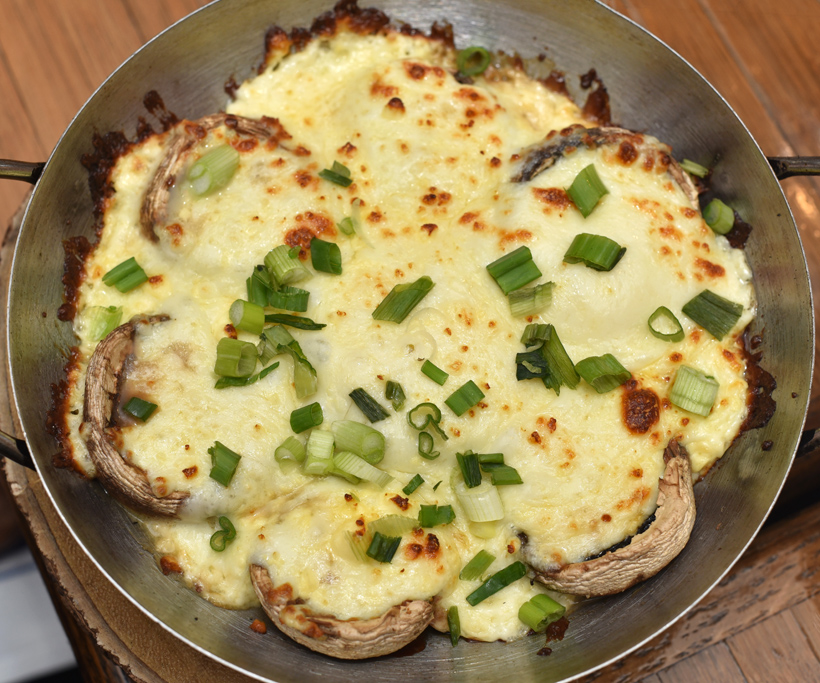
I’ve never quite understood why eggplant rolls stuffed with walnut, a classic Georgian dish, doesn’t have a one-word name. Anyway. The rolls turned out at Cheeseboat are nice, and the paste that fills the fried eggplant slices is made with a lot of ground walnut, plus a bit of cilantro, onion, and garlic. The menu says they’re topped with pomegranate arils, but the cook seems to have forgotten them. Spoiler alert: here shall begin a trend in the rest of this review.

The fried squash nuggets, “minced squash with feta cheese and chopped fresh mint,” are a nice idea. They’ve overstayed their time in the deep fryer, but it’s hard to go wrong with fried dough mixed with cheese. Wait, weren’t they supposed to be made with squash and mint too? I can’t say that I taste either. They’re served with a kind of Thousand Island dressing that’s rather lame, and a few spinach leaves because cookbook photography teaches us that every plate must contains all the colors of the rainbow. Interesting dish, but flawed execution.
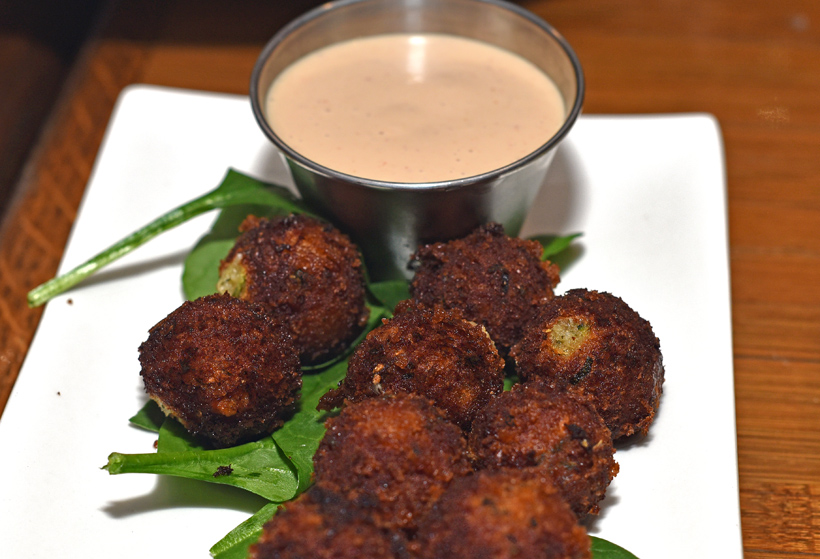
The khinkali are dumplings of “beef and pork seasoned with Georgian spices and salt, served with tzatziki dip,” and topped with parsley. The silky dumpling dough is just the right thickness, and the top isn’t a giant knot of dough as is too often the case. The slightly spicy, finely ground meat filling, shaped like a patty, contains several herbs (cilantro, parsley, maybe others). There’s juice inside, but the meat’s still a little compact and it doesn’t feel very tender (the piece of bone I found in there didn’t help). The tzatziki sauce tastes more like mint than cucumber, but so what? It’s also spicy and crunchy (ground walnuts?), to good effect — it goes very well with the khinkali. The dumplings rest on a bed of raw baby spinach (again), which I suppose is better than a leaf of yellow lettuce. Overall, the dish is quite good but not quite great.

The turkey satsivi consists of “turkey chunks in succulent walnut garlic satsivi, a traditional and popular Georgian dish usually prepared during winter holidays”… “Gobble gobble. Served with bread”. (Except we never got the bread.) Like with all satsivis, the dish is served cold, but it might come as a surprise to many customers since the menu doesn’t mention it and it’s listed as a main. The gobbler is very tender, very well cooked. There’s really a lot of meat too — too often, in other restaurants, it’s just a little bit of meat with a ton of sauce. The tasty sauce strikes the right balance between garlic and walnut, in my opinion, but be aware that it’s still quite a lot of garlic. Much more than in the eggplant rolls, for example. The dish is finished with a drizzle of spicy oil on top.
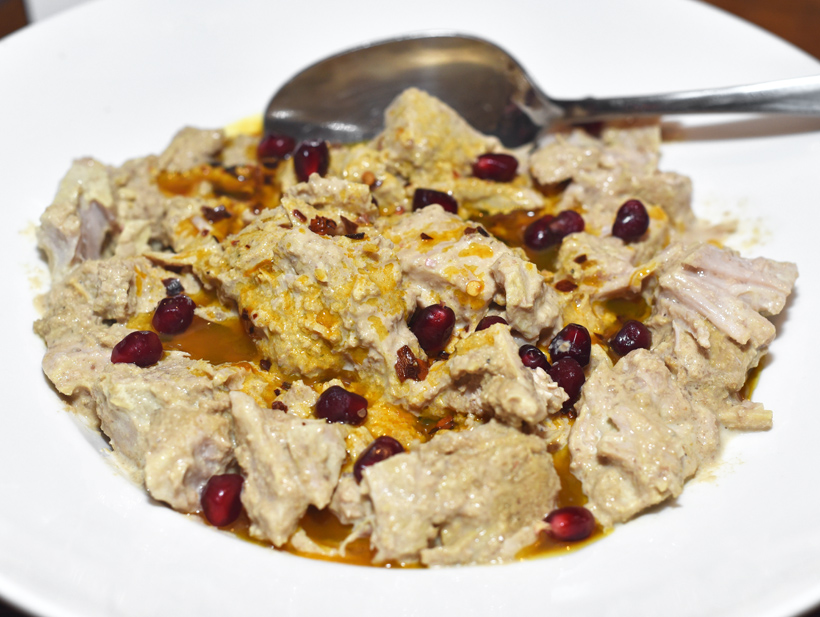
The chicken shish kebab (mtsvadi in Georgian), “grilled marinated chicken chunks with a side of char-grilled veggies,” is a combination of brown and white chicken meat, with no salt. I find it unevenly tender, and dry and overcooked in places. The marinade packs flavors that I can’t quite recognize and could be interesting, but it’s masked by a very spicy red paste spooned on top of the meat. The tkemali sauce served on the side is very sour (duh, it’s supposed to be a sour plum sauce). It looks like the “side of char-grilled veggies” has been replaced with a salad of raw spinach, blueberries, tomato and cucumber, with some kind of blueberry dressing, and fried potatoes that are pretty greasy but not bad (at least they’re salted). All in all, it’s not a satisfying kebab.
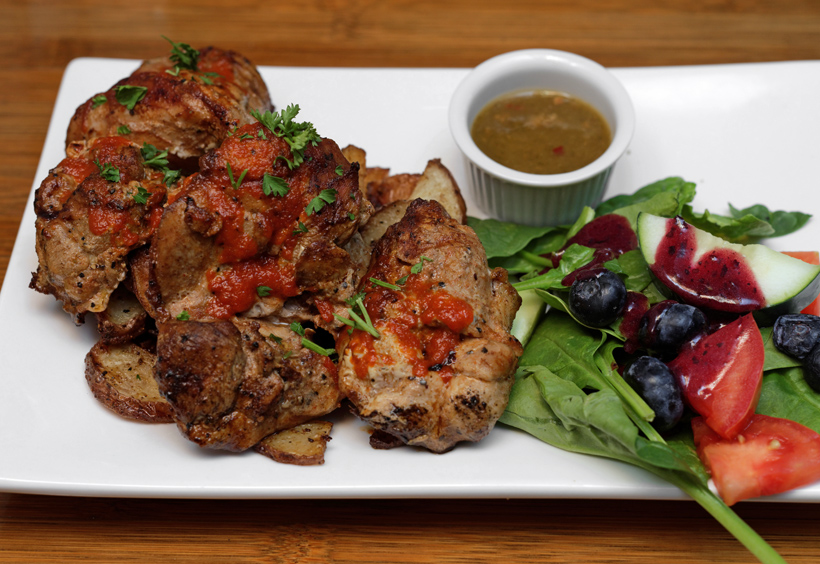
The lamb kebab is “served over pilaf rice with carrots, fresh onions, and Georgian adjika sauce.” The menu also forgets to mention that it’s in fact a lyulya-kebab, which is made of ground meat — if you were expecting cubes of pink juicy lamb, too bad. It’s pretty good for a lyulya though. In the Georgian fashion, the “sausages” are larger than their cousins from Azerbaijan or Uzbekistan. The meat is flavorful and not dry at all. While lyulya-kebab is often wrapped in paper-thin lavash, that has been replaced here with a much thicker, burrito-sized tortilla. The substitution is doughy, unpleasant, and totally unnecessary in an age when Amazon can deliver all kinds of lavash within a couple of days. The Georgian burrito is completed with slices of raw red onion and the same Thousand Island dressing we had on the squash nuggets. Is this supposed to be the adjika sauce? Maybe I wouldn’t mind if it tasted good, but if this is an attempt at an American adaptation of adjika, then I worry that tomorrow’s khachapuri will be a slice of American cheese on Wonder Bread. Finally, the rice with grated carrots doesn’t taste like anything and looks like that par-cooked crap for people who don’t have time to leave a pot on a burner for 20 minutes.
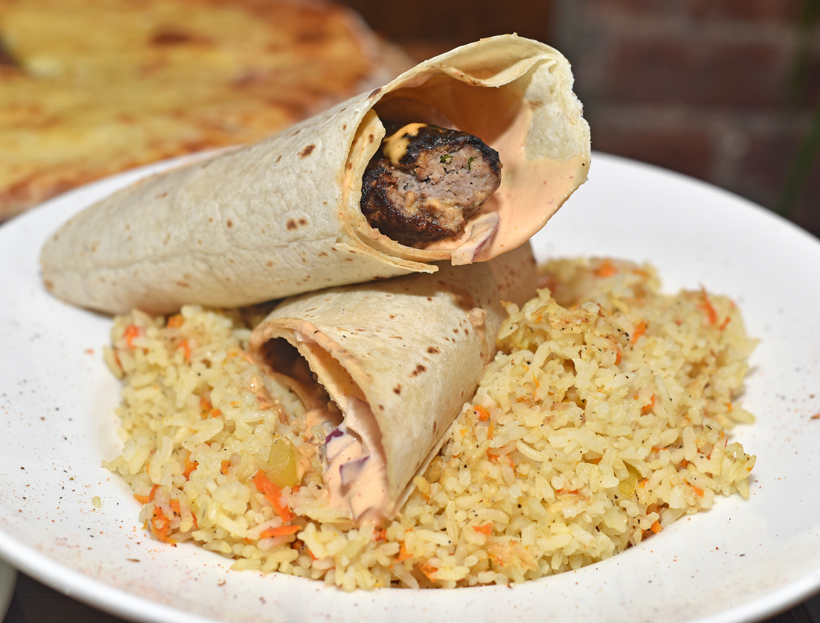
I’ve kept the worst for the end: the dolma, “stuffed cabbage rolls with ground beef and herbs.” Stuffed cabbage is a dish that often looks dull, but these look downright unappetizing from the start. The white cabbage leaves are thick, under-cooked, and unseasoned. The meat filling is very dense, very bland (though I see some parsley and taste pepper), and very unsalted. While the menu says it’s beef, it looks like chicken and tastes like shoe leather. The rolls are boiled in a bland watery broth that pretends to be made with tomato, if I judge by the color. I had only one bite, and regretted it — it reminds me of Soviet canteen food, except the only times I visited Soviet canteens, I was drunk.
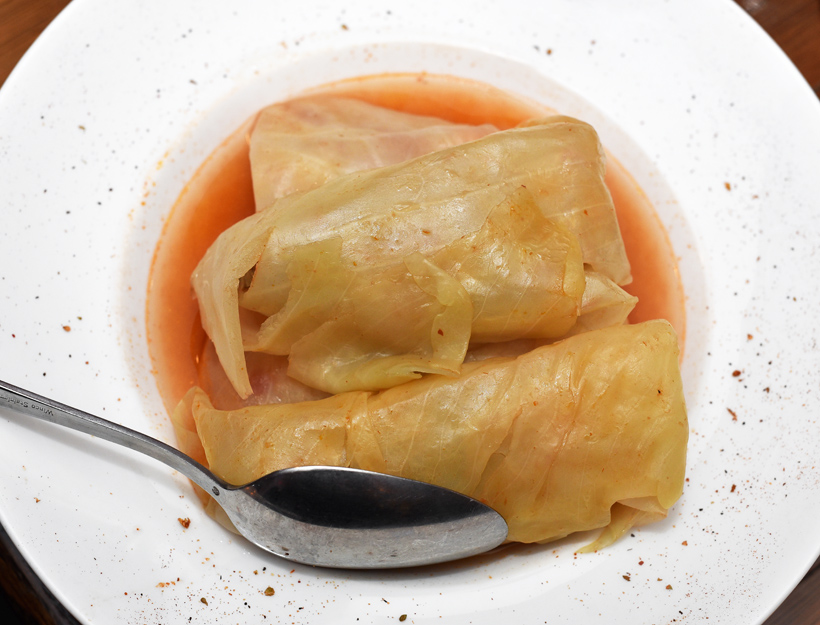
There are a few desserts available (gozinaki, apple cobbler, and the usual honey cake and Napoleon), but I’ve never been hungry enough to even consider trying one.
Cheeseboat has a commendable selection of Georgian booze, and a lot of wines can be had by the glass. The Ojaleshi by Maranuli, a semi-sweet red, and the Satrapezo Saperavi Qvevri by Telavi Wine Cellar, a red wine aged in an amphora, are both typical and pleasant enough. There’s also chacha, the super-strong pomace brandy that invariably reminds me of the denatured alcohol my parents used to keep under the kitchen sink. The menu lists no less than three kinds, but don’t get too excited, for you’ll soon find out that the bar only carries one, an Rkatsiteli chacha. And cocktails! The Georgian peach [insert favorite pun involving “Georgia on My Mind”] is made with peach purée, triple sec, Bulleit rye, and sangria, garnished with mint leaves. It tastes fine, though it’s slightly too sweet and lacking in alcohol. Finally, for those who don’t drink alcohol, the kompot is light and refreshing, not too sweet. I’m not completely sure what fruits it’s made of, but I taste strawberry and blueberry.
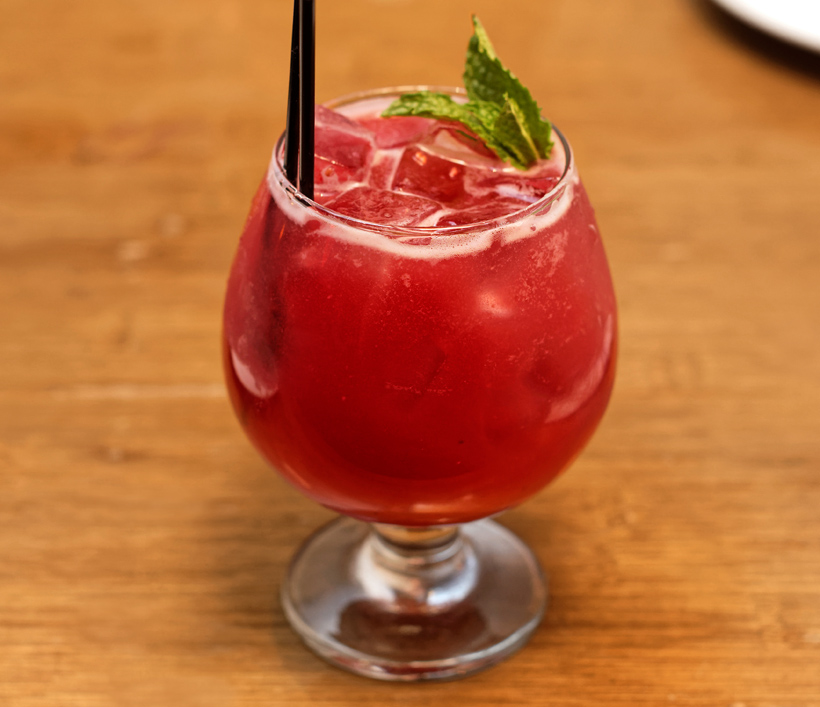
Something must be said about service: it can be funny, slow, disorganized, and/or unknowledgeable at times. On one occasion, we had 3 waiters serving our table, which made things more confusing than efficient. On another occasion, we first got one app and one main because they were served cold and therefore ready first (good thing we didn’t order desserts) and also had to return several (nonalcoholic) drinks for being blatantly other than what we’d ordered. And on yet another occasion, when asked what dishes did or did not contain cilantro, our waiter did several roundtrips to the kitchen and, after much backpedaling, announced that the head chef had confirmed that every single dish other than the cheese breads contained cilantro (and could therefore not be ordered by the hater in our group). Consider this for a second: that would be THIRTY dishes with cilantro, which obviously isn’t true — just look at the dishes I’ve reviewed here. This was not a hard question. If the staff was annoyed by it and didn’t want to answer, I wonder why they bother running a restaurant at all.
I wholeheartedly recommend going to Cheeseboat to try the various cheese breads and other cheese dishes. I can’t claim I’ve had them all, but several pounds of melted cheese later, I can say that many of them are really excellent, and some are rarely seen in other restaurants. I only regret that I didn’t get to try Cheeseboat’s own creations, such as the lobster, prosciutto, or meatball variations. The dishes that don’t contain cheese, on the other hand, can be hit or miss. Some of them would be easy to improve: remove the dolma (stuffed cabbage) from the menu and burn the recipe after dousing in holy water; buy real lavash; throw that Thousand Island crap in the trash; cook real rice from scratch; don’t overcook the kebabs; reprint a menu that matches what’s on the plates… That would add an extra point or two to my rating right there! As it stands, Cheeseboat lands the same rating as Oda House and Old Tbilisi Garden.
Cuisine: Georgian
Picks: cheeseboat, achma, satsivi
Avoid: dolma, adjika sauce, comparing the menu with what’s on your plate, brunch
Food: 7/10


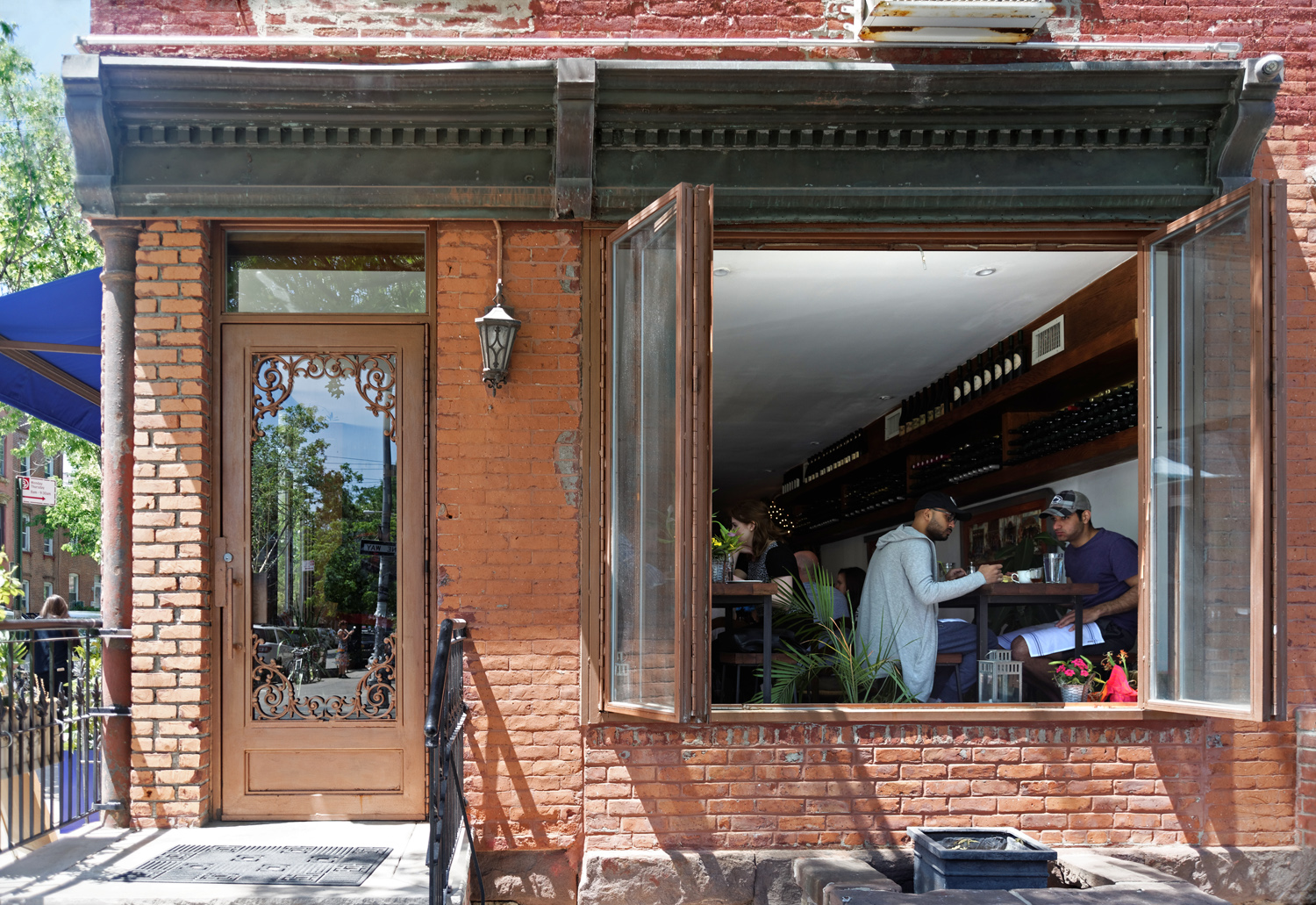





1 comment
That achma looks like what I’ve had made by Mingrelians from Abkhazia…and that stuff is delicious!